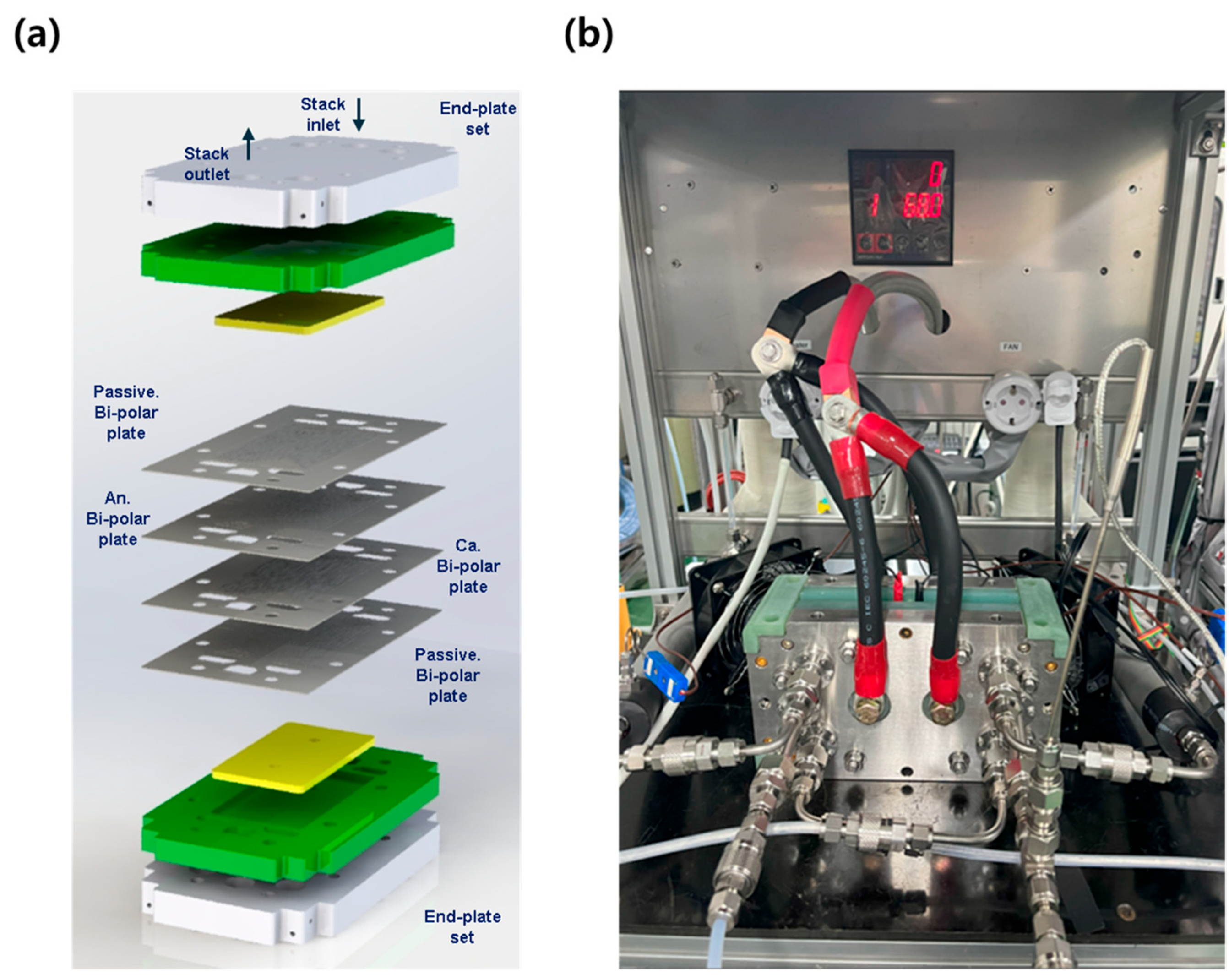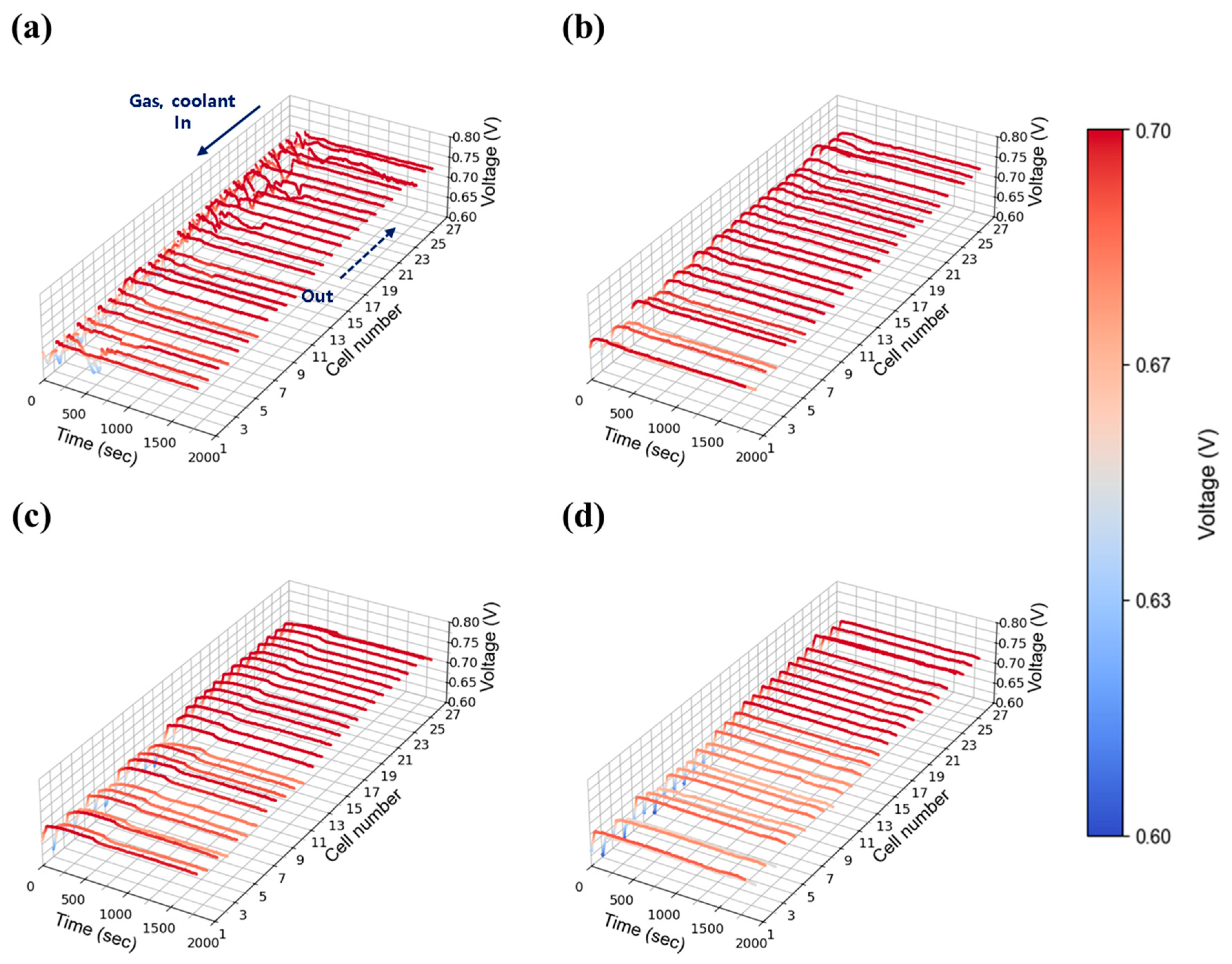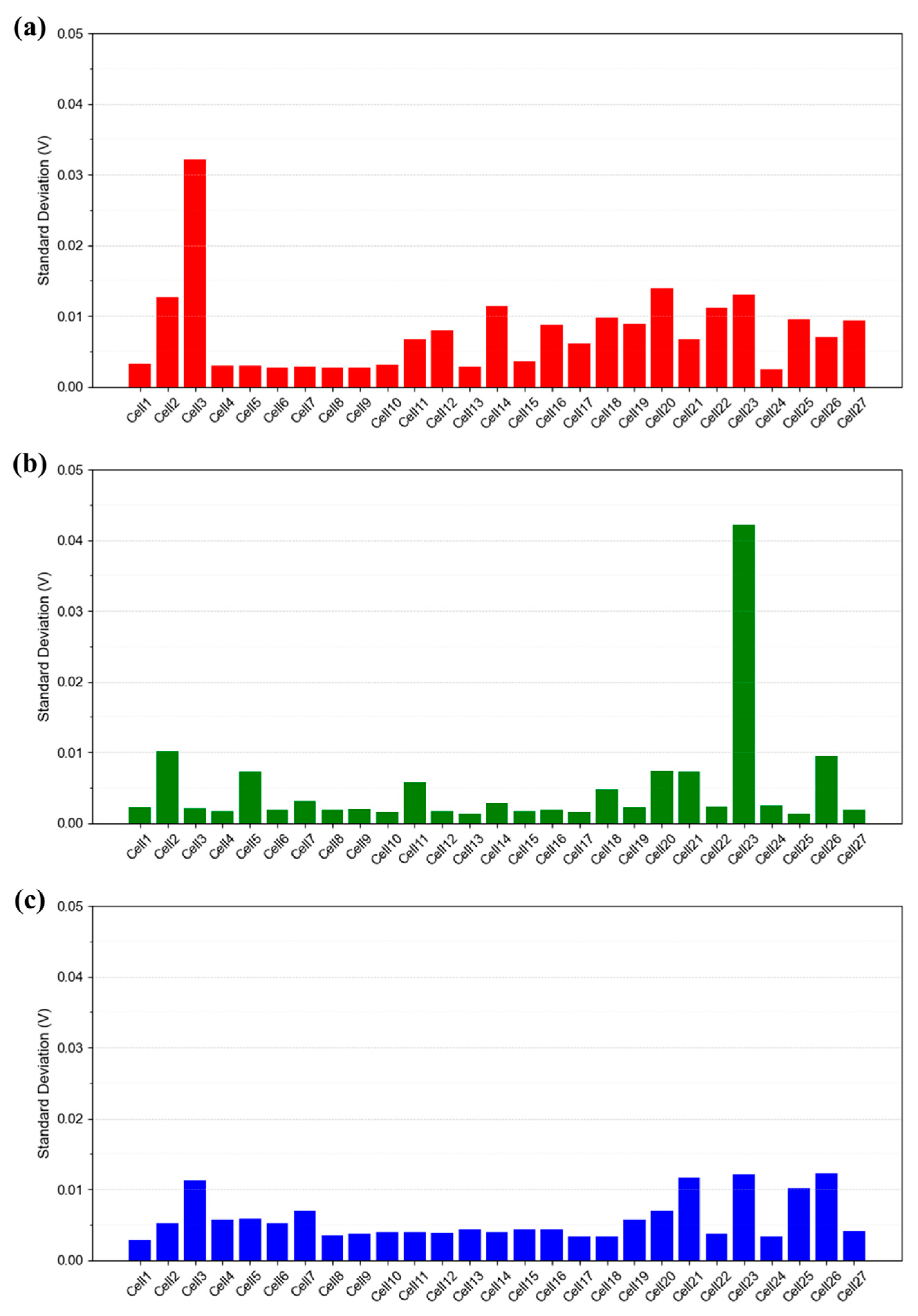Voltage Stability Challenges in a 1 kW-Class PEMFC Stack for Air-Independent Propulsion Applications
Abstract
1. Introduction
2. Experiments
2.1. MEA Specifications
2.2. Single Cell Fabrication
2.3. Single Cell Evaluation
2.4. 1 kW Stack Fabrication
2.5. 1 kW Stack Evaluation
3. Results and Discussion
3.1. Single Cell Evaluation
3.1.1. Gas Pressure (1.0~2.5 bara)
3.1.2. Cell Temperature (35~90 °C)
3.1.3. Relative Humidity (30~100%)
3.1.4. Stoichiometric Flow Rate (1.3~2.0 Stoi’)
3.2. 1 kW Stack Evaluation
3.2.1. Current Density: 0.30 A/cm2
3.2.2. Current Density: 0.55 A/cm2
3.2.3. Current Density: 1.00 A/cm2
3.2.4. Quantitative Comparison of Standard Deviations
4. Conclusions
Supplementary Materials
Author Contributions
Funding
Data Availability Statement
Acknowledgments
Conflicts of Interest
Abbreviations
References
- Tanaka, S.; Nagumo, K.; Yamamoto, M.; Chiba, H.; Yoshida, K.; Okano, R. Fuel cell system for Honda CLARITY fuel cell. Etransportation 2020, 3, 100046. [Google Scholar] [CrossRef]
- Jinnouchi, R.; Kudo, K.; Kodama, K.; Kitano, N.; Suzuki, T.; Minami, S.; Shinozaki, K.; Hasegawa, N.; Shinohara, A. The role of oxygen-permeable ionomer for polymer electrolyte fuel cells. Nat. Commun. 2021, 12, 4956. [Google Scholar] [CrossRef]
- Nonobe, Y. Development of the fuel cell vehicle mirai. IEEJ Trans. Electr. Electron. Eng. 2017, 12, 5–9. [Google Scholar] [CrossRef]
- NEDO Fuel Cell and Hydrogen Technology Development Roadmap. Available online: https://www.nedo.go.jp/library/battery_hydrogen.html (accessed on 5 February 2023).
- Fuel Cell Technical Team Roadmap. Available online: https://www.energy.gov/eere/vehicles/articles/us-drive-fuel-cell-technical-team-roadmap?nrg_redirect=418538 (accessed on 21 November 2017).
- Lim, J.; Shim, J.W.; Kim, D.J.; Park, J.S.; Koo, J.; Shim, J.H. Improvement of fuel cell catalyst performance through zirconia protective layer coating by atomic layer deposition. J. Power Sources 2021, 498, 229923. [Google Scholar] [CrossRef]
- Shang, Z.; Hossain, M.M.; Wycisk, R.; Pintauro, P.N. Poly(phenylene sulfonic acid)-expanded polytetrafluoroethylene composite membrane for low relative humidity operation in hydrogen fuel cells. J. Power Sources 2022, 535, 231375. [Google Scholar] [CrossRef]
- Hasvold, O.; Storkersen, N.J.; Forseth, S.; Lian, T. Power sources for autonomous underwater vehicles. J. Power Sources 2006, 162, 935–942. [Google Scholar] [CrossRef]
- Psoma, A.; Sattler, G. Fuel cell systems for submarines: From the first idea to serial production. J. Power Sources 2002, 106, 381–383. [Google Scholar] [CrossRef]
- Choi, J.W.; Hwang, Y.S.; Seo, J.H.; Lee, D.H.; Cha, S.W.; Kim, M.S. An experimental study on the purge characteristics of the cathodic dead-end mode PEMFC for the submarine or aerospace applications and performance improvement with the pulsation effects. Int. J. Hydrogen Energy 2010, 35, 3698–3711. [Google Scholar] [CrossRef]
- Han, I.S.; Kho, B.K.; Cho, S. Development of a polymer electrolyte membrane fuel cell stack for an underwater vehicle. J. Power Sources 2016, 304, 244–254. [Google Scholar] [CrossRef]
- Han, I.S.; Jeong, J.; Shin, H.K. PEM fuel-cell stack design for improved fuel utilization. Int. J. Hydrogen Energy 2013, 38, 11996–12006. [Google Scholar] [CrossRef]
- Dashti, I.; Asghari, S.; Goudarzi, M.; Meyer, Q.; Mehrabani-Zeinabad, A.; Brett, D.J.L. Optimization of the performance, operation conditions and purge rate for a dead-ended anode proton exchange membrane fuel cell using an analytical model. Energy 2019, 179, 173–185. [Google Scholar] [CrossRef]
- Meyers, J.P.; Darling, R.M. Model of carbon corrosion in PEM fuel cells. J. Electrochem. Soc. 2006, 153, A1432–A1442. [Google Scholar] [CrossRef]
- Roen, L.M.; Paik, C.H.; Jarvic, T.D. Electrocatalytic corrosion of carbon support in PEMFC cathodes. Electrochem. Solid-State Lett. 2004, 7, A19–A22. [Google Scholar] [CrossRef]
- Hegge, F.; Sharman, J.; Moroni, R.; Thiele, S.; Zengerle, R.; Breitwieser, M.; Vierrath, S. Impact of Carbon Support Corrosion on Performance Losses in Polymer Electrolyte Membrane Fuel Cells. J. Electrochem. Soc. 2019, 166, F956–F962. [Google Scholar] [CrossRef]
- Simon, C.; Kartouzian, D.; Müller, D.; Wilhelm, F.; Gasteiger, H.A. Impact of Microporous Layer Pore Properties on Liquid Water Transport in PEM Fuel Cells: Carbon Black Type and Perforation. J. Electrochem. Soc. 2017, 164, F1697–F1711. [Google Scholar] [CrossRef]
- Soboleva, T.; Zhao, X.S.; Mallek, K.; Xie, Z.; Navessin, T.; Holdcroft, S. On the Micro-, Meso- and Macroporous Structures of Polymer Electrolyte Membrane Fuel Cell Catalyst Layers. ACS Appl. Mater. Inter. 2010, 2, 375–384. [Google Scholar] [CrossRef] [PubMed]
- Borup, R.; Meyers, J.; Pivovar, B.; Kim, Y.S.; Mukundan, R.; Garland, N.; Myers, D.; Wilson, M.; Garzon, F.; Wood, D.; et al. Scientific aspects of polymer electrolyte fuel cell durability and degradation. Chem. Rev. 2007, 107, 3904–3951. [Google Scholar] [CrossRef]
- Liu, L.Y.; Chen, W.D.; Li, Y.Q. An overview of the proton conductivity of nafion membranes through a statistical analysis. J. Membrane Sci. 2016, 504, 1–9. [Google Scholar] [CrossRef]
- Lee, C.H.Y.; Kort-Kamp, W.J.M.; Yu, H.R.; Cullen, D.A.; Patterson, B.M.; Arman, T.A.; Babu, S.K.; Mukundan, R.; Borup, R.L.; Spendelow, J.S. Grooved electrodes for high-power-density fuel cells. Nat. Energy 2023, 8, 685–694. [Google Scholar] [CrossRef]
- Lim, J.; Lim, S.; Park, S.; Yang, K.; Park, J.; Kim, M.; Goo, Y.; Um, S.; Shin, D. Modulating the electrode pore structure using the magnetic field for reduced local-oxygen transport resistance in polymer electrolyte membrane fuel cell. Chem. Eng. J. 2024, 498, 155378. [Google Scholar] [CrossRef]
- Su, A.; Weng, F.B.; Hsu, C.Y.; Chen, Y.M. Studies on flooding in PEM fuel cell cathode channels. Int. J. Hydrogen Energy 2006, 31, 1031–1039. [Google Scholar] [CrossRef]
- Tang, X.; Shi, L.; Li, M.; Xu, S.; Sun, C. Health State Estimation and Long-Term Durability Prediction for Vehicular PEM Fuel Cell Stacks Under Dynamic Operational Conditions. IEEE Trans. Power Electron. 2025, 40, 4498–4509. [Google Scholar] [CrossRef]













| Objective | IV Mode | Temperature (°C) | Flow Stoichiometry Ratio | Relative Humidity (%) | Pressure (Bara *) | |||
|---|---|---|---|---|---|---|---|---|
| Chiller Inlet | H2 | O2 | H2 | O2 | H2 | O2 | ||
| Reference | IV1 | 65 | 1.3 | 1.3 | 50 | 50 | 2.5 | 2.5 |
| Humidity control | IV2 | 65 | 1.3 | 1.3 | 30 | 30 | 2.5 | 2.5 |
| IV3 | 65 | 1.3 | 1.3 | 100 | 100 | 2.5 | 2.5 | |
| Flow rate control | IV4 | 65 | 1.5 | 1.5 | 50 | 50 | 2.5 | 2.5 |
| IV5 | 65 | 1.8 | 1.8 | 50 | 50 | 2.5 | 2.5 | |
| IV6 | 65 | 2.0 | 2.0 | 50 | 50 | 2.5 | 2.5 | |
| Pressure control | IV7 | 65 | 1.3 | 1.3 | 50 | 50 | 1.0 | 1.0 |
| IV8 | 65 | 1.3 | 1.3 | 50 | 50 | 1.5 | 1.5 | |
| IV9 | 65 | 1.3 | 1.3 | 50 | 50 | 2.0 | 2.0 | |
| Temperature control | IV10 | 35 | 1.3 | 1.3 | 50 | 50 | 2.5 | 2.5 |
| IV11 | 80 | 1.3 | 1.3 | 50 | 50 | 2.5 | 2.5 | |
| IV12 | 90 | 1.3 | 1.3 | 50 | 50 | 2.5 | 2.5 | |
| Temperature (°C) | Flow Stoichiometry Ratio | Relative Humidity (%) | Pressure (Bara) | |||
|---|---|---|---|---|---|---|
| Chiller Inlet | H2 | O2 | H2 | O2 | H2 | O2 |
| 65 | 1.3 | 1.3 | 30 | 30 | 2.5 | 2.5 |
| 65 | 1.5 | 1.5 | 30 | 30 | 2.5 | 2.5 |
| 65 | 2.0 | 2.0 | 30 | 30 | 2.5 | 2.5 |
| 65 | 2.5 | 2.5 | 30 | 30 | 2.5 | 2.5 |
| 65 | 1.3 | 1.3 | 50 | 50 | 2.5 | 2.5 |
| 65 | 1.5 | 1.5 | 50 | 50 | 2.5 | 2.5 |
| 65 | 2.0 | 2.0 | 50 | 50 | 2.5 | 2.5 |
| 65 | 2.5 | 2.5 | 50 | 50 | 2.5 | 2.5 |
Disclaimer/Publisher’s Note: The statements, opinions and data contained in all publications are solely those of the individual author(s) and contributor(s) and not of MDPI and/or the editor(s). MDPI and/or the editor(s) disclaim responsibility for any injury to people or property resulting from any ideas, methods, instructions or products referred to in the content. |
© 2025 by the authors. Licensee MDPI, Basel, Switzerland. This article is an open access article distributed under the terms and conditions of the Creative Commons Attribution (CC BY) license (https://creativecommons.org/licenses/by/4.0/).
Share and Cite
Lim, J.; Ha, S.; Goo, Y. Voltage Stability Challenges in a 1 kW-Class PEMFC Stack for Air-Independent Propulsion Applications. Energies 2025, 18, 4270. https://doi.org/10.3390/en18164270
Lim J, Ha S, Goo Y. Voltage Stability Challenges in a 1 kW-Class PEMFC Stack for Air-Independent Propulsion Applications. Energies. 2025; 18(16):4270. https://doi.org/10.3390/en18164270
Chicago/Turabian StyleLim, Jinhyuk, Seungwoo Ha, and Youngmo Goo. 2025. "Voltage Stability Challenges in a 1 kW-Class PEMFC Stack for Air-Independent Propulsion Applications" Energies 18, no. 16: 4270. https://doi.org/10.3390/en18164270
APA StyleLim, J., Ha, S., & Goo, Y. (2025). Voltage Stability Challenges in a 1 kW-Class PEMFC Stack for Air-Independent Propulsion Applications. Energies, 18(16), 4270. https://doi.org/10.3390/en18164270





